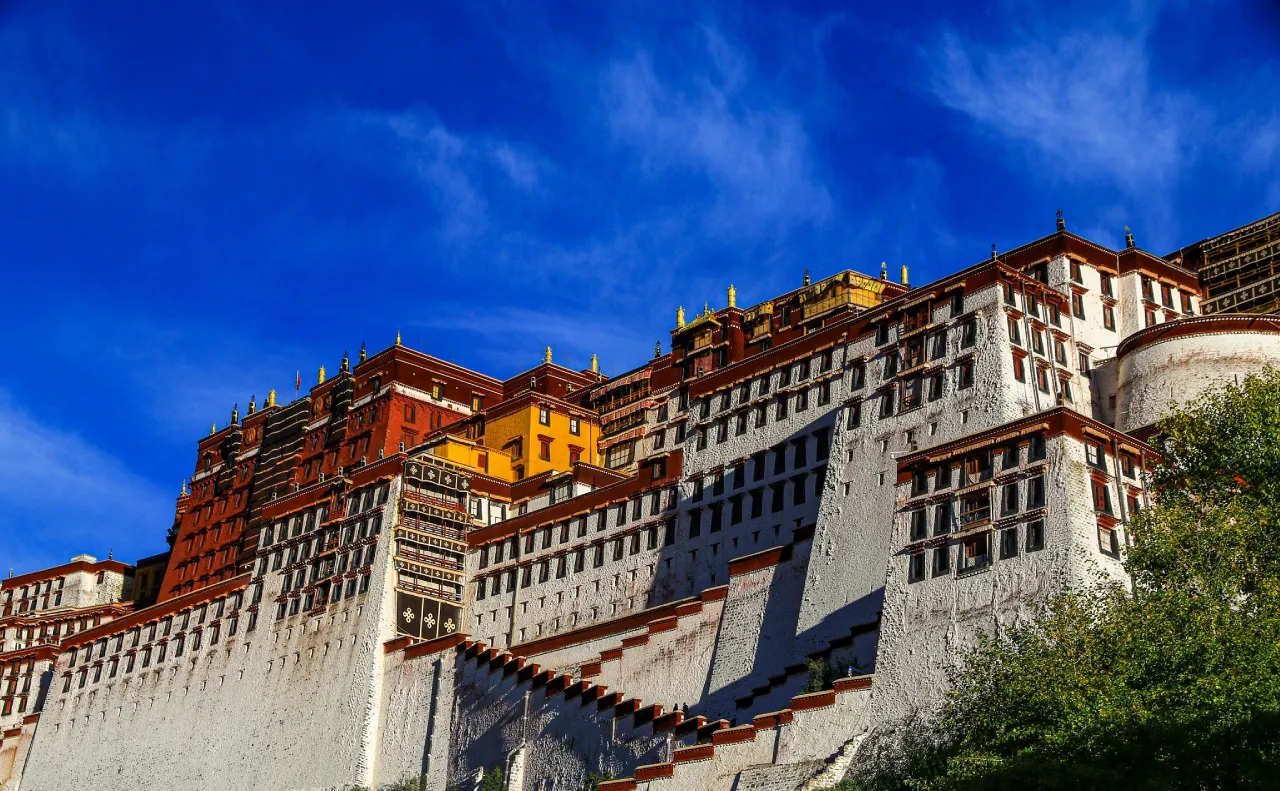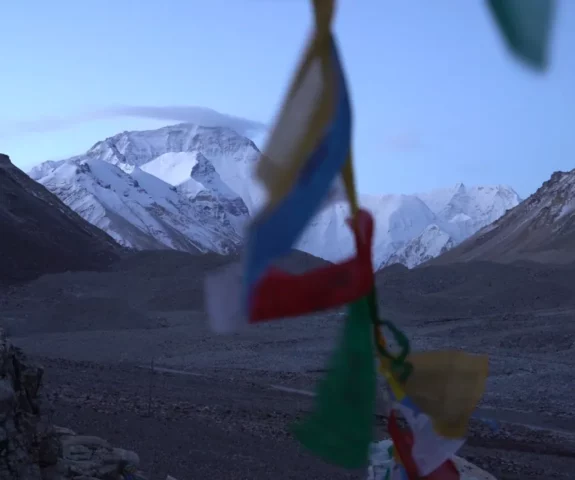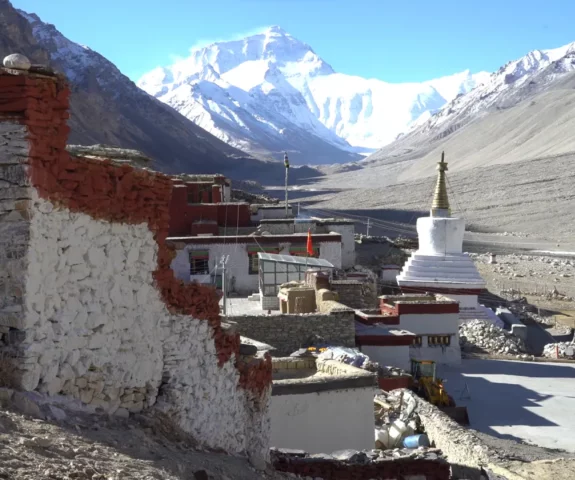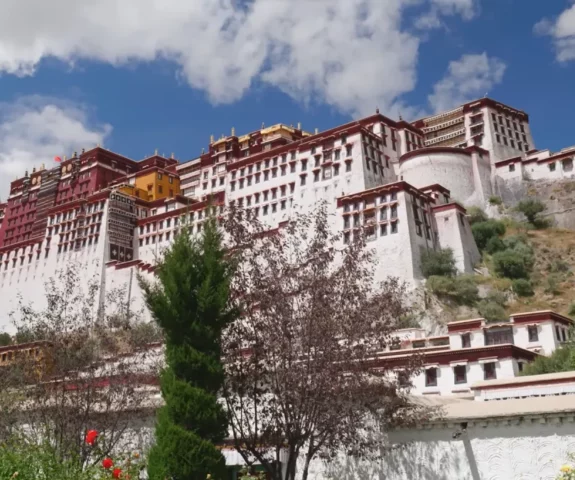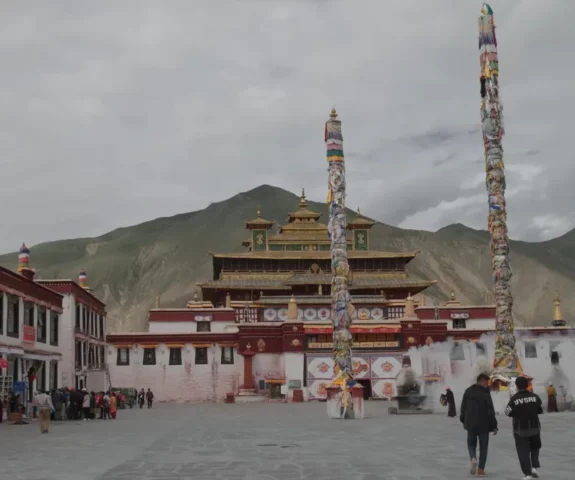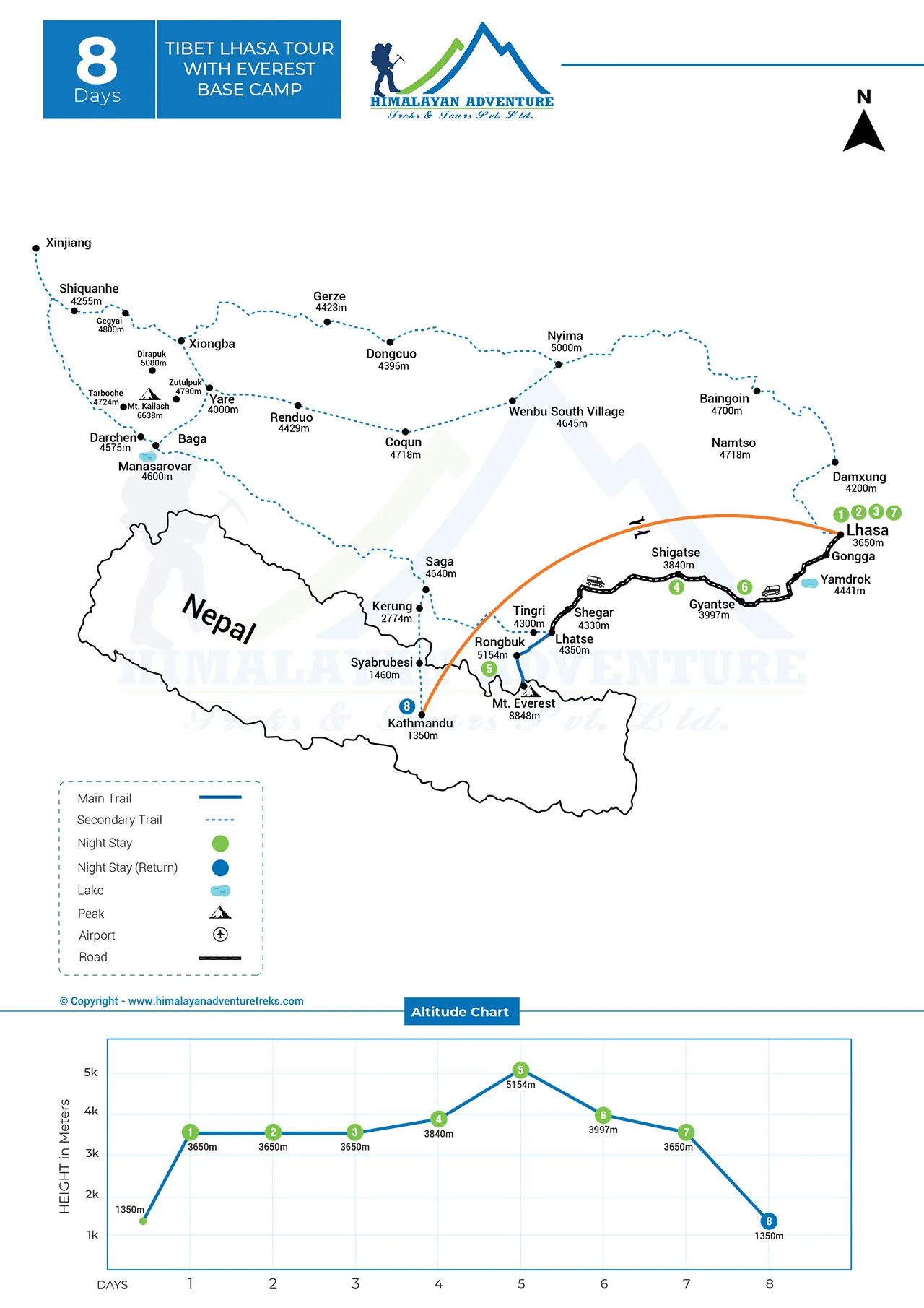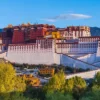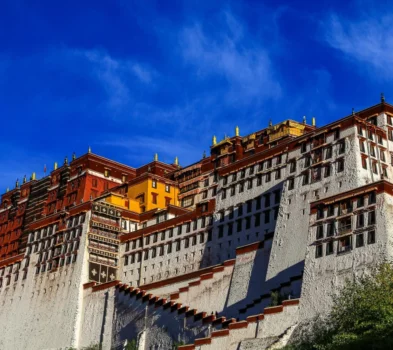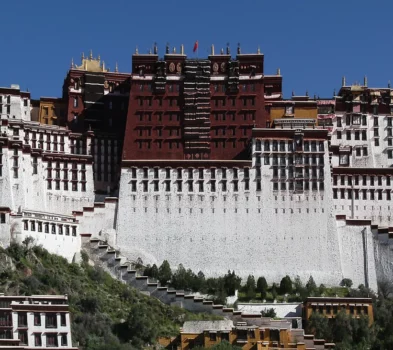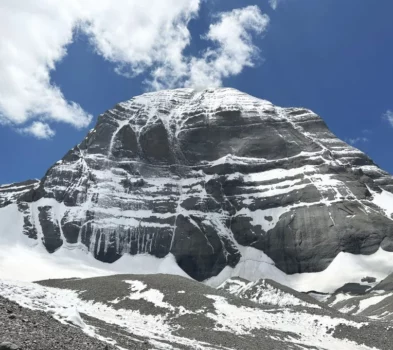Duration
8 DaysTibet Lhasa Tour with Everest Base Camp
Trip Grade
EasyGroup Size
1-16 PeopleMax Altitude
5,250m. / 17,224ft.Best Season
Feb- May/ Sept-NovActivity
TourMeals
BreakfastAccommodation
HotelsTransportation
Private Vehicle & FlightTrip Customization
On request (click here)Highlights of Tibet Lhasa Tour with Everest Base Camp
- An incredibly splendid mountain flight across the Nepalese and Tibetan skies with a thrilling landing at Gonggar International Airport of Lhasa
- A two-day exclusive private tour of the Forbidden Land including an exploration of Drepung, Potala Palace, and Sera Monasteries, Jokhang Temple, and its Barkhor street
- Overland crossing of the massive Tibetan Passes: the great Karo La, Gyatso La and Pang La
- A serene journey along the sacred Yamdrok Tso (Brahmaputra Lake)
- An enchanting navigation through the Gyantse and Shigatse with the exploration opportunities of their specific landmarks such as Kumbum Stupa and Tashilhunpo Monastery
- A night at the serene monastic ground of the Rongbuk and an evening before the majestic Everest
- A brief early morning journey to the magnificent Everest Base Camp An entirely private overland tour with local assistance
- A comfortable and accessible journey that accommodates all travelers
Trip Introduction
So are you searching for an adventure that is genuinely worthy of the name? Then here it is: our Tibet Lhasa tour with Everest Base Camp- a journey among the mountains of Tibet.
With our Tibet Lhasa and Everest base camp tour, we want to offer you a rare experience, a week in the Tibetan highlands, cities, valleys, glaciers, Himalayan passes, and lakes where it is possible to admire landscapes and experience emotions that you will hardly find elsewhere.
In fact, it is a cultural adventure across the Himalayas from Kathmandu to Lhasa and then to the Everest Base Camp that lies below the foot of the beautiful northern face of Chomolungma– the mighty Everest. This majestic peak is not only the King of all mountains but also the beautiful crown of our planet.
With the legacy of the great George Mallory, this base camp is equally beautiful and legendary as its southern counterpart in Nepal.
Additionally, our Tibet Lhasa tour with Everest Base Camp journey will not be limited to Everest Base Camp only, but it will also show you the iconic destinations of Lhasa, Shigatse, Gyantse, and Rongbuk, which are the perfect destinations for adventure travelers. As you progress deeper into the journey, you will also get to walk on earth, rock, and ice.
Our tour mainly concentrates on the southern part of Tibet, which begins with your flight from Kathmandu to Lhasa. Once the forbidden land, today Lhasa is the epitome of a tourist destination.
With two days on hand, you will have the incredible chance to discover its various wonders, especially the marvelous wonder of Potala Palace– the winter home of the great Dalai Lamas, which will enchant you with its white and red counterparts.
Additionally, you will also visit the Sera Monastery, an excellent Buddhist institute where you will see the mutual debate among monks and disciples, the Drepung Monastery– once the administrative headquarters of Tibet, the Jokhang Temple, and Barkhor Market that provides the pilgrims’ route for many from all over Tibet.
Then the travel program of our Tibet Everest base camp tour will take you from Lhasa towards Gyantse along the renowned Friendship Highway.
En route, you will meet the turquoise-colored Yamdrok Tso Lake and the enlarged Karo La Pass before you reach the fourth biggest city of Tibet- Gyantse.
Here, you will have a brief time to explore its amazing Palkhor Chode Monastery and the famous Kumbum Stupa. Then, heading to Shigatse, you will also get to meet the most active monastery of Tibet: the Tashilhunpo – the delightful abode of the Panchen Lama.
As our journey progresses, you will be slowly encircled by the gigantic white islands in the barren landscape of Tibet. Then you will move forward towards the Rongbuk Monastery- possibly the highest monastery in the world, facing the massive yet beautiful northern face of Everest.
With a morning spent in the monastery in front of Everest, you will travel to the newly relocated Everest Base Camp and then begin the end of your journey, taking the same path you have taken before.
We promise you that you will not journey back home without being deeply affected. True, Tibet is a difficult country to travel to, but it imprisons to a degree that is unknown to us in other countries.
Please note that this journey is completely overland from Tibet’s capital through the Himalayas to the Everest area with Rongbuk Monastery and on down to Lhasa again.
Our Tibet Lhasa tour with Everest Base Camp is an exclusive private adventure that will be taken with a lively Tibetan guide and a professional local driver. We will cross the Passes and mountains in a 4-wheel vehicle and take on not only a natural but a fabulous cultural journey through the vast land of Tibet.
This is a truly memorable journey, open to all enthusiasts, particularly suitable in the dry season of autumn and spring. If you have a good physical shape and a spirit of adaptation, then welcome to our Tibet Lhasa and Everest base camp tour- a true classic journey of Himalayan Adventures.
Outline Itinerary of Tibet Lhasa Tour with Everest Base Camp
Day 01: Fly from Kathmandu (1400 m) to Lhasa (3650 m).
Day 02: Guided Sightseeing around Lhasa city (3650 m).
Day 03: Explore more Lhasa city (3650 m).
Day 04: Drive from Lhasa to Shigatse (3900 m) via Gyantse (4000 m).
Day 05: Drive from Shigatse to Rongbuk (4980 m) via Shegar.
Day 06: Hike to Everest Base Camp (5250 m) and drive back to Gyantse (4000 m).
Day 07: Drive from Gyantse (4000 m) to Lhasa (3650 m).
Day 08: Flight from Lhasa (3650 m) to onward journey.
Our guests sharing their experiences (Photo/Video Gallery)
Detail itinerary of Tibet Lhasa Tour with Everest Base Camp
Day 01: Fly from Kathmandu (1400 m) to Lhasa (3650 m).
Get ready for the enthralling mountain flight that you will be taking from one Himalayan nation to another. From TIA, we will take one of the most remarkable flights over the eastern Himalayas and the rugged terrain of Tibet to land in one of the most exciting International airports in the world.
Glancing from the window, the vast allure of Everest, Manaslu, and Kanchenjunga, we will soon reach the Tibetan Sky. After the timeless snowfields of the giant Himalayas, our aerial flight will end at the Gonggar International Airport around 60 km from central Lhasa.
After going through the required customs formalities, we will exit the airport. Here we will be met by the warm local Tibetan guide who will drive us along the expansive Yarlung Tsangpo River (known as the Brahmaputra River) towards our pre-arranged accommodation in Lhasa.
During our journey to this historically significant city, we will observe the remnants of many ruined monasteries. As we start to approach the main center of the city, we will get our first glimpse of the majestic Potala Palace.
Lying atop a cliff, this palace dramatically rises above Lhasa and overlooks the entire city. After we make ourselves comfortable in our room, we will take our first Tibetan lunch and rest followed by a small acclimating walk near the hotel.
Please remember we need to well acclimatize properly to the atmosphere of Lhasa; otherwise, we may experience discomfort during our city tour tomorrow.
Activity: Flight & Sightseeing, 1.5 hours
Max. Altitude: 3,650m/11,975ft. Lhasa
Accommodation: Hotel
Day 02: Guided Sightseeing around Lhasa city (3650 m).
We can’t wait to show you the epitome of this emblematic city- the grand Potala Palace. It used to serve as the warm home during winter for the Dalai Lamas of Tibet. This monumental structure comprises 1000 rooms which makes it one of the largest buildings of Lhasa.
Once inside, you can feel the spiritual aura as you explore the study room and the private room of the Dalai Lamas. It was commissioned by the orders of the 5th Dalai Lama and built on the cliff called Marpo Ri extending to 130 m altitude.
We can observe the beautiful Tibetan ark skills decorating its white and red buildings. The white section was first constructed in 1645 and was completed in 1649 after which Dalai Lama shifted his headquarters from Drepung.
This white building is locally called the Potrang Karpo and its red companion is called the Potrang Marpi which came into existence in 1694. Countless statues of Buddha, colorful mandalas and murals, around 698 wall paintings, and almost 10,000 painted scrolls embellish its walls. Today, this landmark attracts the overwhelming vist from the international tourists.
Next, we will visit the religious heart of Lhasa: the Jokhang Temple which dates back to 700 years of history. Its very oldest sections were commissioned by Songtsen Gampo- the Tibetan son-in-law of Nepal wedded to our princess Bhrikuti.
Before we get inside, we can already see countless pilgrims arduously prostrating themselves. And, when we are inside, we can see the dimly lit corridors that are embellished with small prayer wheels, as well as various halls and prayer rooms. However, the centerpiece is the tall attractive serene-looking statue of Sakyamuni Buddha when he will be at 12 years of age.
The pilgrim route that we saw around this temple is Barkhor Street which by the evening turns into an energetic market that sells everything you can imagine. However, the attraction is the street food stalls with dishes from sweets to savory.
Activity: Sightseeing, 5-6 hours
Max. Altitude: 3,650m/11,975ft. Lhasa
Meal: Breakfast
Accommodation: Hotel
Day 03: Explore more Lhasa city (3650 m).
The third day of our Tibet Everest base camp tour will begin with a visit to Drepung Monastery resting beautifully at the edge of the Lhasa city. Existed since 1416, thanks to the mighty orders of the Chojey Tashi Palden, a disciple of Tsong Khapa, this monastery once used to boast as the largest monastic community in the world, accommodating over 10,000 monks.
Along with Sera Monastery, it is also recognized as one of the Three Pillars of the State. It went through the massive destruction during the period of Cultural Revolution but has now been restored which now houses only 500 monks.
We will now continue to Sera Monastery also known for its large monastic community and Buddhist educational institute. Just at the tale of the Phurba Chok Ri ridge within the mountain range of Tatipu mountain, it was also built by the orders of another student of Tsong Khapa, the Sakya Yeshe in 1419. around 3000 monks now live under its roof engaging every day at noon for a mutual debate.
Activity: Sightseeing, 5-6 hours
Max. Altitude: 3,650m/11,975ft. Lhasa
Meal: Breakfast
Accommodation: Hotel
Day 04: Drive from Lhasa to Shigatse (3900 m) via Gyantse (4000 m).
We are now beautifully acclimatized before we reach the Everest Base Camp. Now, we can thoroughly enjoy our journey as we set on to drive across the high Himalayan terrain of Tibet.
From Lhasa, we will turn southwest and drive along the beautifully expanded Friendship Highway which will take us up to the height of 4797 m of the mighty Kampala Pass. It separates Lhasa from Gyantse and offers the excellent panoramic visual of the Yamdrok Lake.
It appears to be scorpion shaped enchantingly shining with its blue clear waters. It is one of the four pious lakes of Tibet along with Mansarovar, Nam Tso, and Lhamo Lhatso.
The magical mountain Nyenchen Khangsar at 7191 m also sparkles shyly above. We will now keep proceeding along the serene shore of this lake and encounter another magnificent Tibetan pass known as Karo La reaching an impressive elevation of 5010 m.
Gaze at the dazzling snowy realm of Karola Glacier and the beautiful stupa at its base. We will now drive down sharply towards Gyantse – the 4th important and biggest town of Tibet lying tranquilly beside the Nyang Chu River.
After arriving here, we mustn’t miss the opportunity to explore its Pelkor Chode Monastery. Above its gate, we can see numerous stuffed animals which indicate the mount on which the gods arrived in this city.
However, the crowning treasure of this city is the resplendent Kumbum stupa. With 32 m elevation, this stupa is enchantingly decorated with thousand images of Buddhas, and bodhisattvas.
We also can see the gracefully erected Nepalese stupa that depicts the five fundamental elements of the universe: Water, Fire, Air, Earth, and Ether.
It is time that we get on with our journey and drive towards the second biggest and major city of Tibet- Shigatse which is only one hour afar.
Activity: Drive & Sightseeing, 6-7 hours
Max. Altitude: 4,000m/13,123ft. Shigatse
Meal: Breakfast
Accommodation: Hotel
Day 05: Drive from Shigatse to Rongbuk (4980 m) via Shegar.
Let’s make our beautiful morning more delightful with a brief excursion to the Tashilhunpo Monastery which is often translated as the Auspicious Sumeru Monastery.
Smiling atop the Drolmari Peak (aka Tara Peak), it serves as the divine residence of the Panchen Lama. It existed since 1447 due to the high command of the revered Gendun Drup, another brilliant student of Tsong Khapa.
Its splendid architecture signifying the Gelug sect will fill everyone with amazement. It has a magnificent hall adorned with the magnificent sculpture of Shakyamuni Buddha. It is flanked by the figures of Gendun Drup and the 4th Dalai Lama.
Ending our excursion, we will now proceed to get closer to Everest. The picturesque Friendship Highway will once more guide us and lead us to the elevation of 4950 m at Tropu La Pass.
After we drive down the pass, we will reach the pleasant small shepherd settlement of Lhatse. Now the renowned and one of the highest Tibetan pass awaits us ahead of our journey.
The Gyatso La Pass/Lhakpa La Pass rising to 5200 m will bestow us the beautifully magical glance of Everest. We will continue on with our journey and eventually arrive at New Tingri town which is more commonly known as Shegar.
A little further, the checkpoint of the Chinese military will halt us to check our permits and documents. Now, it’s time to part with the comfort of the Friendship Highway and set forth along the dirty dusty, and rugged Tibetan terrain.
It will continue for up to 100 km which will subsequently lead us to Pang La Pass (5150 m). Clear your eyes, and clean your camera lenses, and gaze in front towards the radiant illuminating peaks of Shishapangma (8027 m), Makalu (8485 m), Cho Oyu (8188 m), Lhotse (8516 m), and the stupendous Qomolangma (Everest, 8848 m).
The sharp downward track from the Pass will now take us to the blessed monastery of Rongbuk. Here, Everest reveals its magnificent northern face, captivating every traveler who comes to experience its splendor.
The monastery on the other hand claims to be the highest monastery on the planet. Over 100 years of age, this monastery at one time sheltered u to 600 monks now not more than 20 monks land lamas reside here.
Our night is reserved in the modest guesthouse of the monastery while we will enjoy the evening light and the setting sun rays over Everest.
Activity: Drive & Sightseeing, 6-7 hours
Max. Altitude: 4,980m/16,339ft. Rongbuk
Meal: Breakfast
Accommodation: Hotel
Day 06: Hike to Everest Base Camp (5250 m) and drive back to Gyantse (4000 m).
Truly, there is nothing quite like waking up with Everest in view. It feels like a lifelong dream has come to life particularly as we see the sun beginning to rise casting its morning glow over grandeur of the Everest.
After breakfast, we will board an electric bus and head towards the newly moved base camp of Everest. In the midst of few buildings and the expansive wilderness, the northern wall of Everest stands alone majestically in the distance.
After this grand visual, it is time that we begin the end of our Tibet Lhasa and Everest base camp tour. Driving past the familiar Tingri, Lhatse, and Gyatso La, we will arrive at Shigatse.
After a brief lunch break here, we will resume through Karo La Pass and soon Yamdrok Tso Lake will be seen shimmering in the distance. It will once again show us our way towards Gyantse.
ATTENTION
Please understand that the government of China considering the impact of global warming and pollution has relocated the Everest Base Camp to 1.5 km farther from its original location. The new spot is immensely near to the Rongbuk Monastery. Now only the climbers with a valid climbing permit can have access to the previous EBC.
Likewise, you cannot take any private transportation within a 4 km zone around Rongbuk Monastery. Instead, you will have to make use of an electric bus service that runs every half hour.
Activity: Drive & Hike, 8-9 hours
Max. Altitude: 5,250m/17,224ft. Everest Base Camp
Meal: Breakfast
Accommodation: Hotel
Day 07: Drive from Gyantse (4000 m) to Lhasa (3650 m).
If you didn’t get a chance to explore Gyantse before, you can revisit the city this morning. Then, we will continue our adventure, driving alongside the stunning Yamdrok Lake until we reach the Kampala Pass.
This pass stands between us and Lhasa City. Once we arrive in Lhasa, we will enjoy the vibrant evening atmosphere and lively colorful markets of the city.
Activity: Drive, 6-7 hours
Max. Altitude: 3,650m/11,975ft. Lhasa
Meal: Breakfast
Accommodation: Hotel
Day 08: Flight from Lhasa (3650 m) to onward journey.
Today, you will be leaving the captivating city of Lhasa behind and setting forth on your new journey. Our assigned Tibetan guide will come with you either to the Lhasa Airport or train station (based on your destination), from where you will then set off on your next thrilling adventure.
Activity: Airport drop, 1 hour
Max. Altitude: 3,650m/11,975ft. Lhasa
Meal: Breakfast
Note:
If you have your own private group and want to make your trip private, we can run the custom trip all the day as per your requirements and group size.
Includes and Excludes
What are included with package?
- Transportation during the Tour in Tibet: All transportation within Tibet, including travel by private vehicle, is covered as part of the package.
- Flight from Kathmandu to Lhasa: The cost of the flight between Kathmandu and Lhasa is included.
- Tibet Travel Permit: The necessary travel permits required to visit Tibet are included in the package.
- English-Speaking Tibetan Guide: An experienced English-speaking Tibetan guide will accompany you throughout the tour.
- Everest National Park Admission Fee and Grass Dam Charge: Entrance fees to the Everest National Park and any related charges, such as the Grass Dam charge, are included.
- Accommodation on Twin Sharing Room Basis: Accommodation will be provided in standard hotels on a twin-sharing basis.
- Sightseeing and Monastery Entrance Fees: Entrance fees to the various sightseeing spots and monasteries included in the itinerary will be covered.
- Daily Breakfast: Breakfast at the hotels is included in the package.
- Hotel-Airport-Hotel Transfer in Lhasa: Transfers between your hotel and the airport in Lhasa are arranged and included.
What are not included with package?
- Client and Travel Insurance: Travel insurance covering health, accidents, and unforeseen events is not included. It’s recommended to arrange your own travel insurance.
- Flight Ticket to Lhasa and Back: The cost of the flight to Lhasa from your home country and the return flight is not included in the package and should be arranged separately.
- Tibet Visa Fee: The Tibet visa (or travel permit) is not included and needs to be arranged by you before travel.
- Flight Ticket from Lhasa to Onward Destination: If you need to fly from Lhasa to another destination after the tour, this cost is not covered.
- Lunch and Dinner: Meals like lunch and dinner are not included in the package, and you will be responsible for these costs.
- Personal Expenses: Any personal expenses such as drinks, souvenirs, laundry, extra tips, or other personal items are not included in the package.
- Nepal Re-entry Visa Fee: If you need a re-entry visa for Nepal after visiting Tibet, the fee for this visa is not included.
Pick Your Suitable Date
Book a Private Trip
Private & Group Discount Price
-
1 -
1 person
US$ 2500
-
2 -
2 people
US$ 2400
-
3 -
5 people
US$ 2300
-
6 -
10 people
US$ 2200
-
11 + people
9999
US$ 2100
Total Cost:
US$ 2500
Route Map & Altitude Chart
Kathmandu
Start/End point
Kathmandu
Addon option on Tibet Lhasa Tour with Everest Base Camp
In our Tibet Lhasa tour with Everest Base Camp, we endeavored to make your stay as comfortable as we can therefore we have arranged three-star hotels for all your overnight stays in Tibet.
These hotels offer a combination of Tibetan and Western-style rooms, that come with complimentary WiFi, hot water, humidifiers, and air conditioning, along with in-house restaurants that serve a variety of meals, from Western to national buffet options.
However, all three cities in Tibet now host several luxurious international hotels classified as four to five stars. These accommodations not only provide elegantly designed rooms but also include amenities such as high-speed WiFi, flat-screen televisions, world-class spas, private pools, and restaurants with personalized service.
If you also wish to incorporate luxury into your week in Tibet, please let us know, and we will arrange for an upgrade to your accommodations at an additional cost.
Trip Information
Essential Info
Climate and Best Period for Tibet Lhasa Tour with Everest Base Camp
Tibet has variations in climate patterns depending on the altitude of the region. The major cities where our visit is concentrated are Lhasa, Gyantse, and Shigatse which offer a pleasant experience to their visitors any time of the year.
The climate here is predominantly dry and sunny even during the rainy period stretching from June through the latter days of August. However, the Everest region of Tibet is not so which is significantly affected by monsoon rains.
The area receives rainfall ranging from 94 to 108 mm during this time. On the other hand, the winter months commencing from December and stretching through the latter days of February bring the shivering cold with average heat ranging from -12 to -17 degrees Celsius.
Therefore, with these climatic conditions in mind, it is best that you undertake our Tibet Lhasa and Everest base camp tour during the spring and autumn time.
The spring period commencing from March and stretching to the latter days of May and the autumn period beginning from September and stretching to the latter days of November offer the most comfortable climatic conditions in Tibet.
In spring, the average heat all over Tibet lingers around 12 degrees Celsius and in autumn it significantly drops down to 8 degrees Celsius. The spring blesses Tibet with clear skies with occasional clouds in the morning and afternoon. However, the Tibetan lunar-like landscape including the Everest turns into a multicolored canvas.
On the other hand, autumn offers the clearest blue sky with excellent visibility of the towering Himalayas. June, July, and August on the other hand are the hottest months with an average heat of 25 degrees Celsius.
Although the three major cities may experience some protection from the monsoon rain from Nepal and India but the Everest region remains vulnerable with overcast skies, and heavy rainfall with reduced visibility.
In winter, light snowfall may occur in Lhasa, and mountain passes could be closed to traffic. During this time, many locals in the Everest area migrate to lower regions to escape the cold and undertake pilgrimages to monasteries.
Tibet Lhasa tour with Everest Base Camp Difficulty
Our Tibet Lhasa and Everest base camp tour is overall a uniquely distinct adventure that combines the pleasure of adventure with the convenience of comfortable travel.
If the fear of extensive hiking hours has been stopping you from reaching the crown of the planet, you should certainly engage in our short overland tour that also combines the ease of flying.
During the overland adventure in Tibet, 4-wheel private transportation with a Tibetan guide and driver will be constantly available while the nights will be spent in good solid hotels of Lhasa, Gyantse, and Shigatse.
However, you must be prepared for the basic night at the dormitory of the Rongbuk Monastery, which accommodates 4 to 6 beds per room. The dormitory may not meet your usual cleanliness standards, and the facilities will also be limited, with cold nights and outdoor bathroom facilities.
However, this is the authentic Tibet where you can enjoy the best this region has to offer. Also, being located at almost 5000 m, it is completely understandable for the rustic settings.
Likewise, the roads in Tibet have also been improved than ever before and the long Friendship Highway enhances the travel experience in cities. However, once we leave the Highway, the roads can at best be called a bad country road, although mostly a bumpy dirt road.
And more often it is not there at all, which is why you drive across the plains. There can be a lot of dust along the way, which is why a good scarf or a definite dust mask can be a good idea.
These minor inconveniences are manageable, the main challenge lies in the altitude when the average elevation during the tour will be 3500 m. As it is, the Tibetan air contains less oxygen than in many other regions, so precautions must be taken to prevent hypoxia.
As your true and caring travel companion, we have implemented the essential rule of acclimatization. So you will be thoroughly prepared before you set forth for the Everest Base Camp.
Therefore, this tour is open to everyone as it does not necessitate any previous experience in trekking or mountaineering.
Who can be a part of our Tibet Everest base camp tour?
Any healthy individual between the age group of 10 to 75 years of age is welcome to participate in our Tibet Lhasa tour with Everest Base Camp journey.
The tour contains no grueling trekking days through the undulated terrain. There will be no long suspension bridges, river crossings, or rustic lodging to test your strength. In fact, the entire tour is an overland journey with a gentle Tibetan guide and people as your everyday companion.
The minor setback will be at the Rongbuk Monastery which will be more than compensated by the stunning views of the solitary walls of Mount Everest.
The altitude, the harsher drier air, and the higher medical cost can be problematic for individuals suffering from asthma, respiratory infections, or heart disorders. They can also be harder to cope with for children under ten years and for people over 75 years.
Therefore, we suggest our guests suffering from severe health issues reach their physician and explain to them about the tour you intend to join. Only after his allowance can you join our tour.
So, if you have excellent health, a positive attitude with the good adaptability skills, please don’t think twice about joining our tour today.
Acute Mountain Sickness (AMS)/Altitude Sickness and Acclimatization
Our Tibet Lhasa tour with Everest Base Camp commences with a one-hour short flight from the lowlands of Kathmandu (1300 m) to 3650 high Lhasa. Within an hour, you will experience the altitude increase by almost 2400 m so it is common to feel some mild discomfort.
That’s the reason why we suggest all our guests take abundant rest in their hotel rooms as soon as they arrive in Lhasa rather than venturing out immediately.
We also have allocated two days in Lhasa with a brief exploration tour so all our guests can be properly and completely acclimatized to the Tibetan highland air.
However, as the journey continues, the altitude will rise even further, ultimately reaching 5200 m at Everest Base Camp. This constant increment in elevation heightens the hazard of altitude sickness which presents itself in the form of headaches, breathing difficulty, fatigue, dizziness, appetite loss, restlessness, and numbness.
In our extensive experience of organizing this tour, most of our guests have felt only one or more two symptoms which then disappeared within a day.
If you also feel unwell and manifest any one of the above symptoms, please rest in your hotel, where oxygen is available, and inform our Tibetan guide.
To reduce these risks, we advise you to avoid overexertion by taking comfortable walks and exploring at your own pace. We also suggest you keep away from smoking and alcoholic beverages and shift to consuming dark chocolates and sugar drinks.
For better acclimatization, on doctor’s consultations, you can also take Diamox before beginning the tour from Kathmandu. But be aware to seek supplemental oxygen even in mild discomfort as it may diminish its effectiveness at Everest Base Camp where you may be really in need.
Preparation for Tibet Lhasa and Everest base camp tour
We would like to emphasize that for our Tibet Lhasa and Everest base camp tour, mental strength is more important than physical one. First of all, this journey is a group adventure that needs team effort, social interaction, and of course mutual support.
Second, the Tibet and Everest base Camp may be completely different from what you have imagined and expected. So it is always wise to watch documentaries on YouTube to know precisely what you will see and find in the journey.
You may think there may be no need for physical readiness as the journey is exclusively overland by 4-wheel. However, you will still be touring the major sites, and you will still be at a high altitude where the uncertainties are higher. If you are physically prepared, you can easily overcome any unfavorable incidents with ease.
Concentrate on some aerobic routines such as mild walking, cycling, running, or swimming maybe twice a week. You can also plant one mountain outing at the weekend to gain your own altitude experience.
If you already have any ongoing health concerns, please consider joining our Tibet Lhasa and Everest base camp tour only after you are completely healed. After all, Everest is eternal and it will patiently wait for you until you return to your health.
Sleeping
You will be able to spend all your nights in Lhasa, Shigatse, and Gyantse in a solid tourist standard three-star rated hotel known for the utmost service and amenities for their guests.
Each room will have two nice comfortable beds to be shared among pairs of travelers of uniform genders. The room will feature central heating, an attached bathroom, hot water, with elegant furnishing. We will also determine that the hotel doesn’t lack oxygen supplies.
However, in Rongbuk, you will have to satisfy with the bed in the dormitory where each room will have 4 to 6 beds to be shared with fellow companions. The cleanliness here may not be up to your standard but the views will be beyond your imagination.
After all, this location is indeed the world’s roof so such a minor setting is completely understandable. So we suggest you pack a sleeping bag for a night and get ready to embrace the raw beauty of Tibet.
Eating
The dining option during our Tibet Lhasa tour with Everest Base Camp is self-catered except for breakfast which will be provided in your overnight hotel every morning.
Since the three main cities of Tibet boast wide choices of dining options, and every guest has their own taste and indulgence, we have endeavored to give each one of our guests the independence to choose their own menu.
In Gyantse, Lhasa, and Shigatse, you will find a wide selection of international cuisine along with Chinese and Tibetan specialties. However, in Rongbuk, you may not even have the menu and are offered only Tibetan Meals three times a day limited to noodles, bread, and soup.
But, when you are in three major cities, do not miss the opportunity to take a bite of Tsampa, lamb sausages, dried yak meat, and dumplings. Additionally, you can also explore various Nepali and international bars and pubs, such as Makye Ame, Nepali Low House Music Bar, Ganglamedo Cafe and Bar, and Dunya Restaurant Bar, which provide Western drinks and food with some international loud music.
Please note, the average meal cost including your beverages, lunches, and dinners can range between 25 to 30 US Dollars per person.
Transportation
We will manage your international flight from Kathmandu to Lhasa, and all ground transportation throughout your stay in Tibet will be organized using private four-wheel options, including cars, vans, jeeps, or buses, depending on the size of your visiting group.
However, you will need to arrange your return journey from Lhasa to your next destination on your own. You also have the alternative choice to fly back to Kathmandu if you wish.
Lhasa Flight information
We kindly inform you that implemented from 17th April 2025, daily flights to Lhasa from Kathmandu are no longer available. As of now, Himalayan Airline offers direct Kathmandu-Lhasa-Kathmandu flights every Wednesday, Friday, and Monday.
Supposedly, if your travel program is scheduled on any other day, you will have to travel to Chengdu first and then catch a flight to Lhasa. You can also choose to fly from your hometown to Lhasa instead of coming to Kathmandu.
However, if you happen to select this option, please remember that you must have a Permit for entry into Tibet which is called a TTP (Tibet Travel Permit). Then only you can board in for Lhasa.
If so, you need to have transit of at least 5 hours in any Chinese City where we can send you your permit.
Travel Insurance
Traveling to Tibet is not an easy task and not very cheap as well. In addition, the medical facilities that are available in Lhasa, Gyantse, and Shigatse are very pricey although very high-quality. While the Everest area on the other hand lacks the proper medical amenities.
So if any serious health condition occurs, such as a severe case of AMS, or illness that may require emergency evacuation by air, then it can cost up to 250,000 US Dollars. In the void of insurance policy, you will have to pay this cost yourself.
So travel insurance when visiting Tibet is as important as packing your bags. Please ensure that your insurance policy provides coverage that includes the elevation of up to 5500 m with the added coverage of trip cancellations, theft, delays, or lost belongings, as well as medical expenses.
Mobile and Internet in Tibet
Your home carrier may offer roaming services in China that will allow you to use your own phone when in Tibet but you have to be cautious of the high roaming charges.
Therefore, the most economical way is to buy a local SIM card instead. When you land in Lhasa, you can ask our Tibetan guide for assistance to purchase a local China SIM card. There are several networks to choose from, but Unicom, China Mobile, and Telecom perform better in the Everest and Tingri regions.
All these networks also provide 5G coverage, even at Everest Base Camp! Additionally, you can opt for an eSIM from these providers, which can be activated after you arrive in Lhasa. It will be the most practical and easy option for communication in Tibet.
WiFi is also easily and readily available in Lhasa, Gyantse, and Shigatse, although it may be absent at Everest Base Camp and Rongbuk. Before you travel to Tibet, don’t forget to install a trustworthy VPN app on your phone, as China restricts access to many Western sites like Facebook, WhatsApp, Google, YouTube, and Instagram.
Currency, Exchange, Credit Cards, and ATM
The currency that you will be using when in Tibet is called the Chinese Renminbi Yuan (RMB). Already at the Lhasa Airport, you can easily exchange your currency into Chinese one or you can choose to exchange them at the bank counter of the Bank of China.
Please remember, that the bank remains closed on weekends just plan your exchanges on other days. You can also carry Euros or US Dollars for the on-spot exchange. Most hotels will also offer you this service at a hefty commission.
So the most convenient option would be to convert your money when you are in Kathmandu through banks like Nabil Bank, Standard Chartered Bank, Everest Bank, Nepal SBI Bank, and Himalayan Bank.
In Lhasa, Gyantse, and Shigatse, you will be able to use ATM services that will allow you to take out the money with your debit or credit cards such as Master Card or Visa Card.
However, make sure to check with your bank about the additional charge that may cost during the cash withdrawal process and also ask about the limitation amount.
Instead of cash, you can also consider using your credit cards when you are in these three major Tibetan Cities where their acceptance and use are increasing every day.
However, in Rongbuk and EBC, you must have only cash as it is one of the primitive areas of Tibet. You can also install and load the amount in mobile e-wallets that are commonly used in Tibet such as Alipay, WeChat, and Apple Pay.
Protocols to Follow for Tibet Lhasa Tour with Everest Base Camp
Google may suggest you can travel on your own to Tibet but it is not so. Like Bhutan, the country also doesn’t allow any foreign travelers to explore Tibet independently. Instead, each traveler must engage the assistance from recognized travel agency.
Every detail of the tour must be well-planned and the proposed travel program must be specified clearly when applying for the permit to get into Tibet. Thus, please reserve our Tibet Lhasa tour with Everest Base Camp a month or two before your intended departure date.
Likewise, just like the Bhutan Government, the government of China will also allow the tour in Tibet only if you are in the company of a licensed local Tibetan guide, driver, and a private 4-wheel drive. Thus, the tour to Tibet becomes additionally expensive. Along with the transportation, the accommodation will also have to be pre-arranged and pre-booked.
As for the permits, since our destination will be a special Everest Base Camp as well, so we must have other obligatory permits which we will soon be mentioning.
If you decide to get into Tibet from Kathmandu (chosen method by most of the international tourists due to easiness), then please remember you must arrive 4 to 5 days early.
From Nepal to China visit, a valid Chinese Group Visa is obligatory different from the individual Chinese Visa needed when you decide to step in the Tibetan border from other locations.
The duration for managing for the Chinese Group Visa from Nepal will take approximately 3 to 4 business days. This duration is necessary for your agency (we if you choose us) to complete the processing of the visa.
After receiving the advance booking payment from your side, we will need the following documents from you:
- White background 51 mm X 51 mm Recent Photos, free of make-up, and glasses at the time of registration
- Colored scanned copy of your original Passport
- Your passport must have more than six months of validation period counted from your departure date
- Must have three blank pages on your Passport
Chinese Group Visa and Obligatory Permits for the Tibet Everest base camp tour
As your travel ally for traveling to Tibet in Nepal, we will guide you through the process of securing the Chinese Group Visa and will also manage the initial procedures of acquiring the Tibet Tourism Bureau permit.
Please note that the TTB Permit is part of our Tibet Lhasa tour with Everest Base Camp package cost along with the admission fee for the Everest Base Camp and Grass dame charge. However, the charge for the Chinese Group Visa does not fall under our service fee.
- TTB (Tibet Tourism Bureau) Permit
If you are a non-Chinese citizen and don’t have a legally valid Chinese Passport, then you must have the TTB Permit more commonly referred to as Tibet Travel Permit/TTP or Tibet Visa to step into the confined territory of Tibet.
This permit is granted only by the Tourism Board of Tibet which is issued to the visitor through the licensed local travel agency of Tibet. Remember, it cannot be obtained elsewhere: not in the embassy or in consulate office.
Once your Tibet Lhasa tour with Everest Base Camp is finalized, and you make the pre-payment for the tour, we will request you to submit us the documents that we have listed above.
Then, we will forward all your documents along with the travel plan, number of days, and accommodation details to our authorized Tibetan tour and travel agency.
You need to remember that once we forward all the details of your travel program, it cannot be modified. To change your travel destination and route, a new set of permits has to be re-applied.
Once the TTB verifies your travel program and documents, they will send us the authorization letter through our Tibetan agency which we will then use to apply for the Chinese Group Visa.
You will need to show this Group Visa when boarding your flight to Lhasa, while the TTB permit will be collected by our assigned Tibetan guide who will present it at the Lhasa Airport.
- Chinese Group Visa
When you decide to board for Lhasa from Kathmandu, remember, that you need to have a Chinese Group Visa but not a Chinese Visa. A Chinese Visa is granted for one traveler while the Chinese Group Visa is provided as a single document for all participating members of the group.
It means, all the guests partaking as a group must all at once enter and leave Tibet. Please also understand that this group visa cannot be processed in advance as your original passport and biometric registration must be completed at the Chinese Embassy in Kathmandu.
Thus, you must arrive in Kathmandu 4 to 5 days before your planned trip date. Once you are in Kathmandu, we will assist you with the Group Visa application and take you to the Embassy of China in Kathmandu where you need to deliver the original copy of your passport along with your fingerprints.
The embassy officials will retain your passports for 2 to 3 days and will return them with your official Visa. There are two ways we can process your Group Visa: one is the standard way which costs fairly less than the express way.
The standard method will take four office days to process your Group Visa while the Express way will give your Visa within three office days. The rate per the method of application is as follows:
For US Nationals:
- Standard Chinese Group Visa Fee: USD 175 per person
- Express Chinese Group Visa Fee: USD 185 per person
For Non-US Citizens
- Standard Chinese Group Visa Fee: USD 70 to USD 170 per person (based on our home country
- Express Chinese Group Visa Fee: USD 90 to USD 180 per person (based on our home country)
- Other Mandatory Permits
Because the Everest Base Camp of Tibet belongs to the military-controlled and unopened area of Shigatse, our tour will need several additional permits including a Military Permit, a Foreign Affairs Permit, and an Aline’s Travel Permit.
Among these, Aline’s Travel Permit will be available on-site at the office of the Tibetan Local Public Security Bureau, whereas the other two require a minimum of 15 days of processing before the beginning of the tour.
Our Tibetan partner will oversee the processing of all necessary permits, which will be gathered by our Tibetan guide.
Essential Packing List for Tibet Lhasa Tour with Everest Base Camp
Traveling is mostly about enjoying and experiencing the destination, however, if you want to get the most from your little holiday, then appropriate travel gear is also a must.
It may seem a chore to you, but some of the items and equipment are such that you would hate to be without them. Here, we have listed some must-have gear that will take up very small space in your backpack and is also legal to travel with.
- Your Passport
- Visa
- Passport Photos
- Local Currency
- Credit or Debit Cards
- Emergency Contact Info
- Booking Information
- Health Insurance
- First Aid Kit
The backpack is a more comfortable, easy-to-carry, manageable, and convenient option than carrying a heavy suitcase when traveling abroad. You can carry almost all your gear in it without much load. We suggest you have one main and another secondary backpack: the main backpack will have large storage for all your equipment and belongings, and the secondary backpack will be used to travel light during the day.
- Main Backpack: Good quality waterproof lightweight with volume up to 45 to 60 L with a good hip-belt
- Secondary Backpack: Foldable, durable, lightest, and smallest
- Foldable Travel Toiletry Bag
- Carrying case or waterproof cover for your main and secondary backpack to protect from dust, water, and dirt
- Camera Backpack
- Document bag
- Waterproof Jacket
- Light Down Jacket
- Rain Coat
- T-shirts (long and half-sleeved) and Tank Tops for the hot days
- Fleece Jackets
- Hoodie
- Sweatshirts
- Wool sweater
- Durable, lightweight, quick drying Hiking Pants
- Some Jeans for a casual look
- Canvas or cargo pants with numerous pockets
- Shorts
- Leggings for women
- Skirt (long for visiting temples and monasteries for women)
- Long Dress for some formal occasions
- Bras (Sports bras would be preferable for comfortable traveling)
- Panties
- Briefs
- Boxers
- Socks (Cotton and woolen, quick drying)
- Flip-flops or sandals
- Canvas sneakers
- Trail shoes for light walking and touring
- Swimsuit
- Hat, cap
- Bandana and masks
- Scarf, shawl, or foulard
- Handkerchief
- Gloves
- Sleeping Bag, Hammock, Tent for nature trips ( Optional)
- Earplugs
- Inflatable pillow or cushion
- Sleeping or an eye mask
- Sunscreen or sunblock
- Sunglasses
- Chapsticks or Lip Balms
- Moisturizer
- Deodorant
- Light, quick-drying towel
- Phone with charger, headphones, memory cards
- Camera with replacement battery, memory cards, and charger
- Notebook computer, tablet
- GPS or GPS Watch
- Universal Adapter
- Power Bank
- Solar Charger
- Toothpaste
- Shampoo
- Toothbrush
- Comb
- Soap
- Hand sanitizer
- Sanitary Pads
- Padlocks
- Head torch
- Multipurpose knife
- Lighter or matches
- Whistle
- Thermal Blanket
- Flashlight
- Compass
- Mosquito spray or repellent
- Water Filter
- Antiseptics
- Painkillers such as Aspirin or Ibuprofen
- Bandages
- Tweezers
- Thermometer
- Disposable gloves
- Your prescribed medications
- Common medicines for diarrhea, nausea, and vomiting
- Anti-allergic medications
- Moleskin or blister pads
- Altitude sickness medication (Diamox)
- Eye and ear drops
- Safety Pins
- Gause Pads
- Scissors
Destinations in Tibet are also very child-friendly, so you may decide to join in with your kids as well. Traveling internationally with children, however, means an extra suitcase, extra space, and items. For your stress-free travel, we have listed some essential equipment when touring with children, whether they are older or newborn.
- Enough diapers and wipes
- Baby bottles and infant milk, if necessary
- Easy to put on and take off baby clothes
- Portable changing mat
- Lightweight folding stroller
- Insulated bag for storing meals
- Reading or coloring books, card games, board games, or cartoon games on an iPad
- Travel Potty
Equipment Note:
- We understand that not every item that we have listed here is essential. The traveling items depend on what you need, your destination, the type of tour, and a number of days you have allocated for your tour.
- So, review our list and pack only what is necessary for you. The main aim is to travel as light as you can and comfortably without the burden of extra luggage. Most of the items here can even be purchased in Tibet.
Frequently Asked Questions
Are there any unsaid rules that I must have the knowledge about when I am in Tibet?
Yes, please remember that smoking in public places is not allowed in Tibet; you may only smoke in specified areas. When you visit monasteries and heritage sites, please dress decently and avoid any attire that may expose too much skin. Please do not take photographs of military personnel, and if you wish to photograph local people, please ask for their consent beforehand. Lastly, refrain from shouting the name of the Dalai Lama or phrases like “Freedom for Tibet,” and do not carry his posters.
Is my journey to Tibet totally safe?
In the heart of Tibet, non-violence and peace reigns supremely. There will be monks everywhere to guide people while also the military personnel to look after the safety. There are also multiple CCTV cameras in the streets and many tourist attractions so everyozne will be continuously monitored. In addition, our Tibetan guide and driver will be constantly by your side so our Tibet Everest base camp tour is 100 percent secure and safe tour.
Why are only 10 to 75-year-old people allowed on your Tibet Everest base camp tour?
No, all people enjoying prime health can partake in our tour. We suggested this age group because younger children under 10 mayn’t express any physical discomfort they may experience at high altitudes. Additionally, elders over 75 also may encounter breathing challenges.
What is the overall cost of your Tibet Lhasa tour with Everest Base Camp?
Depending on the total number of participants in the group, the cost can vary between 2,200 to 4,000 US dollars for each tourist.
Do I have to stick to the mentioned destinations? Can I not modify my travel plans?
After you get the TTB Permit, you can only travel to the specified routes and destinations. Changing the location or route is not permitted once TTB Visa has been granted.
Do I have to present a permit when departing from Tibet?
Yes, you must present your Visa and permit when departing from a train, flight, or overland crossing to Nepal.
Which one do you think is more attractive: the Everest Base Camp on the Nepalese side or on the Tibetan side?
The southern Nepali Everest Base Camp is a paradise of nature, filled with lush greenery, colorful blooms, and enchanting wildlife. However, to really be up close to Everest, you will need to hike to Kala Patthar the next day. It is just one to two hours afar from the base camp but once there, you will be in the stunning Himalayan realm of Nepal.
On the other hand, the northern Tibetan Everest Base Camp journey is more about comfortable travel where you can only see the solitary walls of Everest amidst the barren Martian landscape.
So if you are looking for a more relaxed journey to the base camp, the northern EBC in Tibet is a better option, but if you seek the beauty of nature, the southern EBC in Nepal will be the ultimate choice.
Can I myself arrange the TTB permit?
No, you can receive the TTB permit through the government-approved travel agency only.
When will it be appropriate to reserve your Tibet Lhasa tour with Everest Base Camp?
Since TTB Permit processing will take around 15 days so we suggest you reserve our tour at least a month before your targeted departure date.
Is there any option you have for a last-minute booking of your Tibet Everest base camp tour?
No, you cannot make last-minute bookings for any Tibet tour.
Is the Everest Base Camp in Tibet still at the new location?
Yes, as of now, the base camp is still in a newly shifted location.
Can I not opt to visit only the three cities and skip the Everest Base Camp tour?
Yes, but you have to notify us about your preferred travel program before we apply for TTB.
Is there any other alternate option to travel to Tibet?
Yes, you also have the option of overland border crossing via Kerung from Nepal.
Is there any problematic section in your Tibet Lhasa tour with Everest Base Camp?
Yes, when you are set to spend an evening and a night at Rongbuk Monastery. It will be the maximum height of the entire tour as well as the setting will also be pretty rustic.
Why is the Tibet tour so pricey?
Because of the necessity of the organized tour with a private vehicle, driver, and local guide along with pre-arrangement of government-approved lodgings and several permits.

